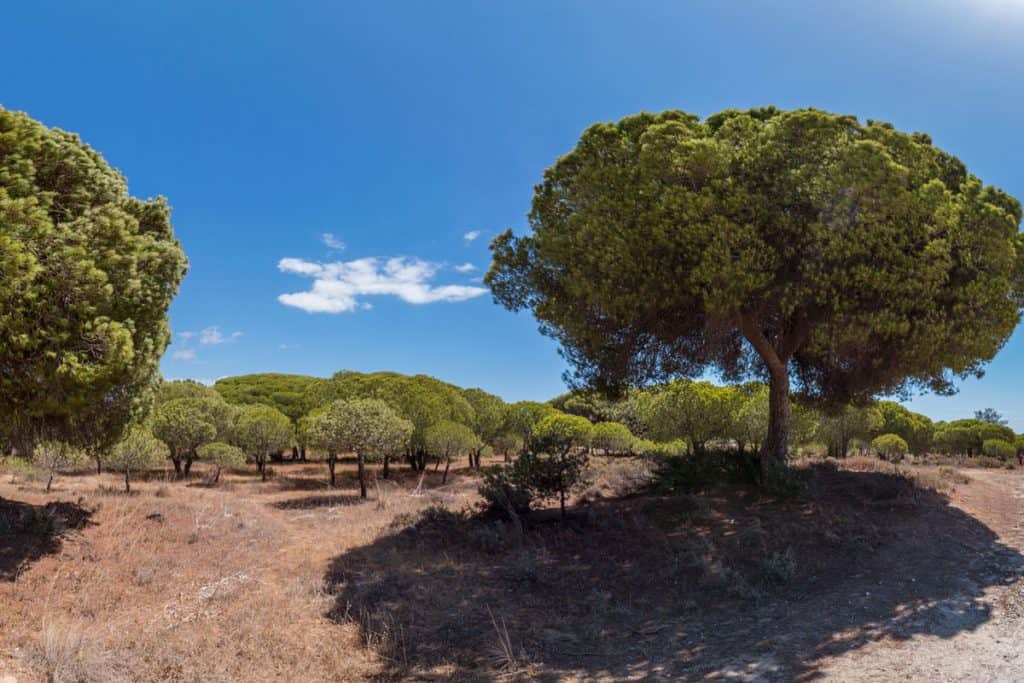 The Italian Pine or Italian Stone Pine (Pinus pinea) is also known as an umbrella or parasol pine because of its whimsical, unique shape. It has a jaunty hat of foliage above a tall, slightly spreading base which gives it a beautiful silhouette that resembles an umbrella. A dark bark and pine green needles provide rich color to a landscape, but it's perhaps most well-known for its fruit.
The Italian Pine or Italian Stone Pine (Pinus pinea) is also known as an umbrella or parasol pine because of its whimsical, unique shape. It has a jaunty hat of foliage above a tall, slightly spreading base which gives it a beautiful silhouette that resembles an umbrella. A dark bark and pine green needles provide rich color to a landscape, but it's perhaps most well-known for its fruit.
What Is An Italian Pine Tree?
This beautiful, uniquely shaped tree is gorgeous in the landscape but probably most well-known in the kitchen. A native of Mediterranean countries, the Pinus pinea, or Italian Stone Pine is most well-known as being the cultivar where pine nuts come from. Love your pesto? Then thank this tree.
A native of Southern Europe, Israel, Lebanon, and Syria, this tree has an ancient history that dates back to prehistoric times. In Rome, the trees line historic roads, and they were planted along coastlines in Istanbul during the Ottoman period. Now they can be found in countries throughout the world, both as beautiful garden specimens, bonsai ornamentals, and food crop plants.
How To Grow The Stone Pine Tree?
The Italian Pine is an incredibly versatile tree. While it is probably most often grown outdoors in its natural tree form, smaller specimens can be grown in large pots and planters, and some are even used for bonsai. Naturally, the Italian Pine grows to heights of 40 to 80 feet. It will grow around 15' in the first five years of its life. Sometimes, young seedlings of about 8-12" are used as tabletop Christmas trees.
Planted outdoors, the Italian Pine prefers well-drained, slightly acidic soil. It needs full sun and likes a drier climate. In the United States, it's suitable for USDA zones 8 and above. In colder and windy climates, the needles will brown, so it's probably not the plant for those living in northern states.
Growing The Italian Stone Pine In Containers

If you want to have an Italian Pine as a houseplant, the great news is that you can. You'll need to start with a pot that's suitable or the size of your plant and a general houseplant potting soil. Be sure to spread the root ball out a bit if you are transferring from a nursery pot to your decorative pot.
This pine wants bright light so a southern sunny window is the best choice. Grow lights can be used if they emulate sunlight. Your pine likes moist and well-drained soil. Check the top 2-4" of your soil and if it's dried out, then it's time to give it another drink.
Planting The Italian Stone Pine In A Container
- Buy your nursery plant
- Choose the garden pot for your space, make sure it has holes for drainage
- Fill loosely with a good quality potting soil; it can have fertilizer in the mix
- Fill to about 2" from the rim
- Remove your Stone Pine from its nursery pot
- Break open the root ball to free up the roots a bit
- Dig a hole into your potting soil and place plant gently inside
- Press soil gently yet firmly around the root ball
- Place in a sunny location
- Water
- Fertilize once in the spring with a slow-release fertilizer
- Replace the soil every two years
Plant Gallery - Italian Pine or Stone Pine
We've assembled a beautiful collection of Italian Pine images to show you the plant in many different settings. This should give you great ideas for how to use the plant in your own space.
1. A Parade Of Parasols
The Italian Pine tree isn't called the parasol or umbrella tree for no reason. Its happy crown resembles the top of an umbrella and looks charming in the landscape.
2. An Ancient And Beautiful Tree
The Italian Pine is seen all over Italy and lines many ancient roads. Here one looks over the Coliseum in Rome. Can you imagine the things this tree has seen over the years?
3. Structurally Unique
The Italian Stone Pine branches as it ages and the trunk grows thicker and more substantial over time. Here a gorgeous specimen is a focal point at the end of an Italian street.
4. An Iconic Mark Along Mediterannean Landscapes And Ocean View Points
These trees were planted along coastlines for generations. Their tolerance for heat and for full sun makes them a no-brainer for dry, warm climates.
5. Line Your Streets With Italian Pines
Because of their high canopy and outstretched branches, the Italian pine is a safe choice for lining a driveway or road. There's no worry about branches that will hang low and cause interference with a passing vehicle. Plus they're absolutely beautiful.
6. Use As A Strategic Part Of An Overall Landscape Design
Here gorgeous Italian Pine specimens are used for their height and spread in this well-planned oceanside resort landscape. Mixed with smaller palms and other hot weather plants, these commanding pines serve as sentinels for the overall look.
7. Mix With Other Conifers
Here Italian Pines flank smaller conifers. The juxtaposition of shapes makes a lovely natural hedge and boundary marking.
8. Nature's Umbrella
Here a mature Italian Pine makes an elegant mark on the landscape and serves as the perfect complement to the majesty of the mountain soaring behind it.
9. The Italian Pine Is A Beautiful Potted Plant
When buying an Italian Stone Pine from a nursery, you don't have to transfer to an outdoor landscape. Find a decorative pot and transfer straight into your sunroom for interior beauty every day.
10. A Forest Of Italian Stone Pines
The lack of lower branches makes this forest of Italian Pines feel absolutely magical. A perfect place for a game of tag or hide and seek. Put in a gorgeous path and meander among the tree trunks.
11. The Source Of Delicious Pine Nuts
Inside each of those pine cones are multitudes of delicious pine nuts. Blend some good olive oil, basil, parmesan and pine nuts for fresh pesto. And what would be more fulfilling than using pine nuts from your own garden? And having a beautiful tree to boot.
12. Simply A Beautiful Tree
This beautiful mature stone pine is all the landscaping this homeowner needs. Its beautiful shape is candy for the eye and its spreading parasol of a canopy provides needed shade for the home.
13. Prune to Encourage Less Height And More Spreading
This specimen tree has been pruned to allow for more side to side spread than upright growth. Here it looks gorgeous in a Florida landscape.
14. The Winding Road To Horticulture Happiness
We love this image because it seems as if the Italian pines are pointing the way to the garden of our dreams.
Where To Buy The Italian Pine Online
If you want to start with seeds for this beautiful plant, you can find a 4 pack of 5 seeds each. They'll take about 4-5 weeks to germinate and might benefit from a 24-hour water soaking before planting in your nursery pot.
Click here to find seeds on Amazon.
Would you rather start with a seedling? You can find those too. This small seedling will arrive well-packaged and alive and ready to plant in your pot or garden.
Click here to find this on Amazon.
Here you can find one with an even bigger start. Use it indoors as a tabletop holiday tree, then when the weather warms up, transfer it outside. This 4" pot contains a 12" mini-tree (about a year of growth for a stone pine seedling).
Click here to find this plant on Amazon.
Want to try an Italian Pine as Bonsai? Well here is everything you need to get you started.
Click here to see this on Amazon.
The Italian Pine is a beautiful tree. Whether you choose to plant it outdoors in all of its magnificence or use it indoors to keep you happy through the winter, you can't go wrong with this choice of plant.
If you enjoyed this plant guide, please be sure to stop by these other posts we think you'll find interesting below:




